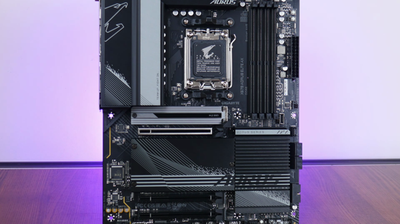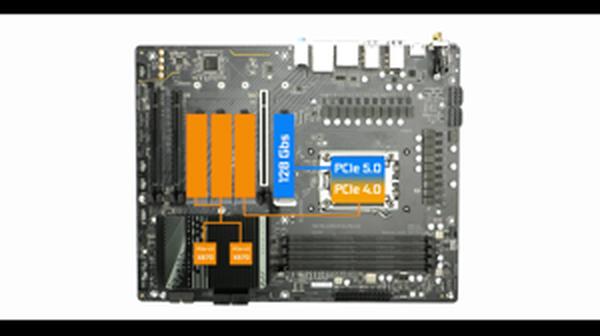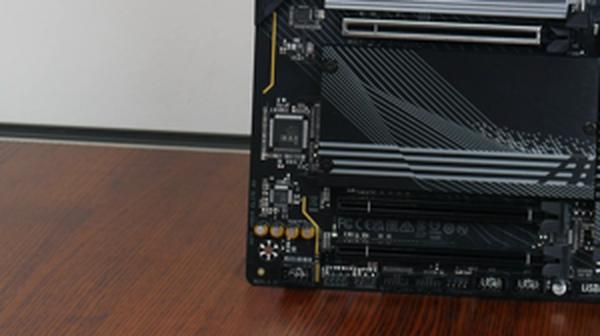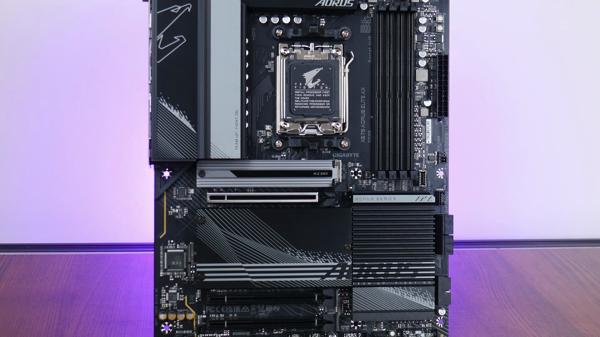
My impressions of the GIGABYTE X670 AORUS Elite AX AM5 DDR5 WiFi 6E Motherboard (2024)
My thoughts on the GIGABYTE X670 AORUS Elite AX's performance, design, connectivity, and BIOS features.
Introduction
I recently upgraded my PC with a GIGABYTE X670 AORUS Elite AX motherboard to go along with an AMD Ryzen 7000 series processor. The compatibility and performance of this board were key in my decision. I spent quite some time getting everything set up - below is my experience with the motherboard.
Some photos (click to enlarge)




Specs of the GIGABYTE X670 AORUS Elite Motherboard
- Release Year
- Brand
- Chipset Type
- Compatible Devices
- Compatible Processors
- Cpu Socket
- Memory Clock Speed
- Memory Storage Capacity
- Model Name
- Platform
- Ram Memory Technology
Prices
Performance and Compatibility with Ryzen 7000 Series Processors

When I decided to upgrade my rig with the latest AMD Ryzen 7000 series processors, the GIGABYTE X670 AORUS Elite AX immediately stood out as a strong contender. The board's performance and compatibility with these high-end CPUs were critical factors in my decision. I appreciate the 5-year warranty - it's a reassuring nod to the board's long-term reliability.
Here's a quick rundown of the aspects I focused on:
AMD AM5 Socket: A perfect fit for the Ryzen 7000 series, ensuring seamless CPU integration.
DDR5 Compatibility: Future-proof with support for the latest memory modules.
Chipset Type: The AMD X670 chipset is designed specifically for enthusiast-grade performance.
However, let's get into more specifics. The motherboard's commanding power design with a 16+2+2 phase VRM ensures stable and efficient power delivery, a necessity for the newer, power-hungry Ryzen CPUs. During testing, I didn't encounter any power throttling and the CPU ran at peak performance without a hitch.
As for memory, having DDR5 compatibility is a game-changer in terms of system speed and responsiveness. I initially slotted in 64 GB of DDR5 RAM and the board handled it admirably, even when pushing it to 5600MHz. That being said, I've noted some reviews mentioning potential stability issues with specific memory kits. It's worth double-checking the motherboard's memory QVL (Qualified Vendor List) to avoid these niggles.
The motherboard's layout and socket design made the CPU installation straightforward. No complaints there. The M.2 EZ-Latch feature for SSDs is a small, but incredibly convenient touch, making upgrades hassle-free.
That said, no product is without its drawbacks. A few users have reported teething issues with getting their systems stable at the advertised memory speeds, often requiring BIOS updates to rectify. It's a minor inconvenience, but worth noting for those less tech-savvy.
In my case, after ensuring that the BIOS was updated to the latest version (F20a at that time) which I strongly recommend doing before any setup, everything worked in harmony. I paired the board with an AMD 7800X3D and was blown away by the performance at my preferred settings of 1440p Ultra in games like Star Citizen.
In summary, my personal opinion edges towards the positive given my hassle-free experience. The GIGABYTE X670 AORUS Elite AX delivers on its promises of being next-gen ready and ensuring that your system can harness the full potential of a Ryzen 7000 series CPU. Just keep an eye on the potential need for a BIOS update and verify your RAM's compatibility, and you should have a powerful, future-proof system at your fingertips.
Design and Thermal Management Highlights

In my journey with the GIGABYTE X670 AORUS Elite AX, I've found that its design and thermal management are standout features that deserve a spotlight. When it comes to building a PC, especially one intended for gaming or heavy workloads, how well a motherboard handles heat is a crucial component to consider.
Here's the breakdown of my observations:
Direct 16+2+2 Phase Digital VRM Solution: Ensures smooth power delivery to the most power-hungry components.
8-Layer 2X Copper PCB: Provides a solid foundation that helps with heat dissipation.
These key points contribute to the overall advanced thermal design of the board, which has been a joy for me to witness in action. The board includes rigorously engineered M.2 Thermal Guards that have been fantastic at keeping my NVMe SSDs cool under intense operations. It's reassuring to know my drives aren't going to throttle due to heat.
Another piece I appreciate is the Ultra Durable Armor, which is not just for show. It gives the PCIe slots extra strength, and I have to say, it offers a level of confidence when installing hefty GPUs.
While the board comes with many future-proof features, like PCIe 5.0 for instance, I have to acknowledge that not everyone may have the components to fully utilize these features yet, so it could be seen as a bit ahead of the curve. However, for those looking to invest in longevity, this is a clear advantage.
It's not all sunshine, though. One drawback I've encountered is the positioning of the fan headers. Having more headers near the top of the board would be a welcome improvement, offering better cable management and easier access when you're trying to build a neat setup.
All these factors considered, the GIGABYTE X670 AORUS Elite AX has shown to me its exceptional ability to manage heat while delivering a commendable design structure. The reality of building with this motherboard is that there's peace of mind in knowing that the board's architecture supports consistent performance without letting heat become the enemy. Despite some minor frustrations in layout and possibly premature next-gen features, it's a board that promises an up-to-date build ready to meet future advancements head-on.
Connectivity and Expansion Options Review

One of the reasons I leaned towards the GIGABYTE X670 AORUS Elite AX was the robust connectivity and expansion options it promises. The motherboard does not disappoint in this regard, coming equipped with a slew of modern ports and slots that are crucial for a future-proof build. Here's my rundown:
PCIe 5.0 support: Future-proofing my PC with the latest technology is a big deal, and PCIe 5.0 is a game-changer for anyone looking to harness the fastest speeds for graphics and storage.
Quad NVMe x4 M.2 slots: The ability to run multiple NVMe SSDs is phenomenal for setting up a system with plentiful, lightning-fast storage.
USB-C and Bluetooth 5.2: It's great having the latest standards for both wired and wireless connectivity.
However, in as much as the M.2 EZ-Latch is a nifty feature, enabling quick and screwless installation of M.2 drives, I do have concerns about the long-term durability of this mechanism compared to the traditional screw-in approach.
On the networking front, having both 2.5GbE LAN and AMD WiFi 6E offers versatility whether I'm wiring up for gaming or relying on wireless for a clean and minimal desk setup.
That said, while I appreciate the ample USB ports, I do have qualms about the placement of some headers, which seems a bit inconvenient for cable management. It's a minor gripe but worth mentioning if you're particular about a neat internal layout.
Although the dynamic audio and high-end capacitors speak to quality, the onboard audio isn't the most impressive. If you're an audiophile or needing studio-level sound for content creation, you may want to invest in an external DAC or a sound card.
In terms of drawbacks, the inconsistent experience with the first boot and RAM compatibility can be disconcerting. These issues are not unique to GIGABYTE, but they do remind me that bleeding-edge tech sometimes comes with growing pains.
Overall, the X670 AORUS Elite AX offers an impressive suite of features that are well-calibrated for those looking to build a high-end PC with plenty of room for expansion. While it's not without its faults, I've found most of its features to work as advertised, making it a solid choice for the discerning PC builder or gamer.
Here's a quick list of the standout features:
Next-gen PCIe 5.0 for top-tier performance in graphics and storage.
Multiple M.2 slots with a user-friendly EZ-Latch system.
An ample array of USB and networking options including 2.5GbE LAN and WiFi 6E.
Despite the issues I've mentioned, the GIGABYTE X670 AORUS Elite AX remains a motherboard I'd recommend, particularly for those who want to make the most out of AMD's Ryzen 7000 series processors.
BIOS Updates and Memory Optimization Experiences

Navigating the BIOS updates and memory optimization for the GIGABYTE X670 AORUS Elite AX has been a journey mixed with both challenges and triumphs. Here's a personal breakdown of my experience:
BIOS Updates: When I first set up the board, I updated to the latest BIOS version (F20a at the time). This step was crucial and set the stage for a stable system. BIOS updates are common with new platforms, and while it can take a few minutes to complete, it's worth the stability and performance enhancements.
Memory Optimizations: Working with DDR5 and getting it to run at advertised speeds of 6000 MHz took some tweaking. Initially, there were stability issues, but after checking the compatibility and QVL (Qualified Vendor List), and another round of BIOS updates, my system is running smoothly at 5600 MHz.
Pros:
Regular BIOS updates improving stability and compatibility
QVL is very helpful when selecting compatible memory modules
Memory running at high speeds benefits the overall system performance
Cons:
Preliminary stability issues with memory
Requirement to be proactive with BIOS updates for optimal performance
From a personal perspective, it's been rewarding to see the progress from an unstable system at launch to one that's rock solid now. I appreciate BIOS updates like F8c, which proved to be a game-changer for my system's memory stability. The importance of updating the BIOS cannot be overstated—it's transformed my experience from frustrating to exhilarating as my system harnessed the full potential of the Ryzen 7000 series.
However, the initial memory instability and crashes made me realize something crucial - it’s essential to refer to the motherboard's QVL. When the exact modules weren't listed there, the system would boot but experience frequent crashes. It led me to pay close attention to memory specifications and compatibility.
The potential performance gain in games and applications from running memory at 6000 MHz is noticeable, but not game-changing. That said, there was a sense of satisfaction in getting the setup right and seeing those numbers in the BIOS.
In conclusion, ensuring proper BIOS updates and memory compatibility are critical steps when building a system with the GIGABYTE X670 AORUS Elite AX motherboard. The learning curve is steep, but for those willing to put in the time, the payoff is a stable, high-performing gaming or productivity machine. Despite some initial hurdles, my overall sentiment is positive, thanks largely to GIGABYTE's frequent firmware releases and a motherboard that demands but ultimately rewards an enthusiast's patience and tenacity.
Comments (0)
Share